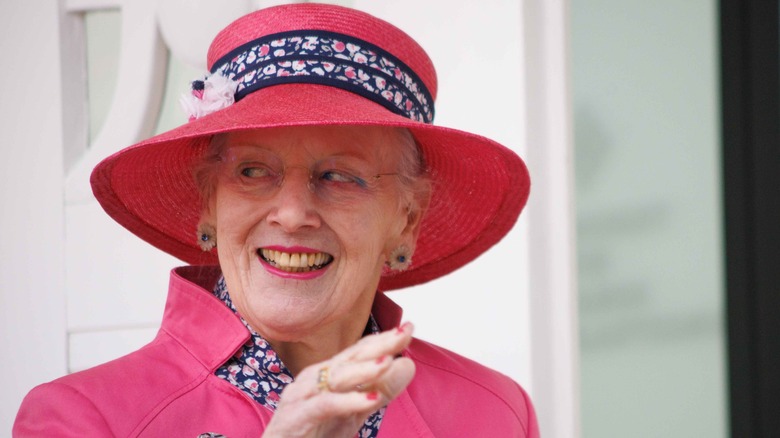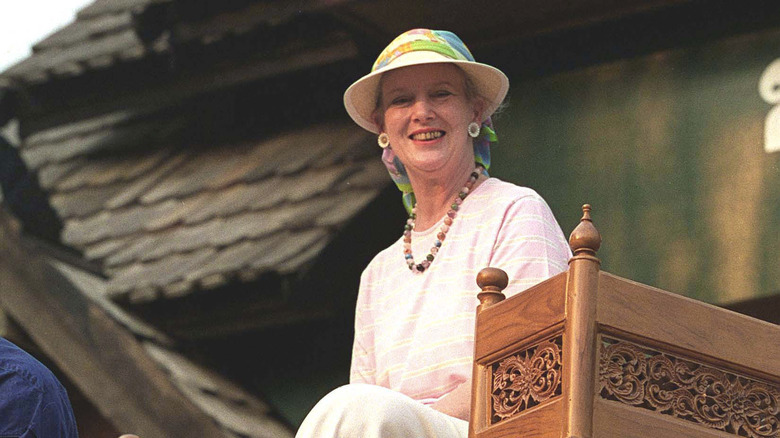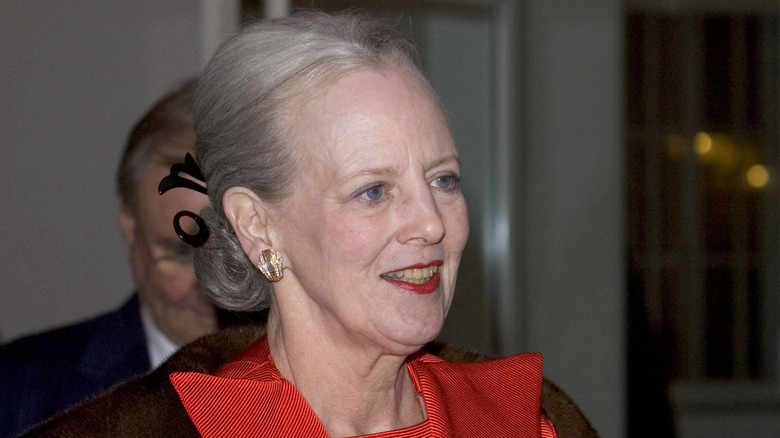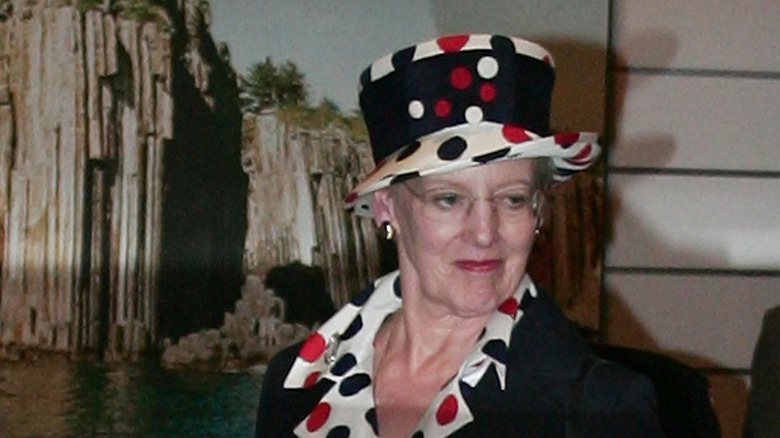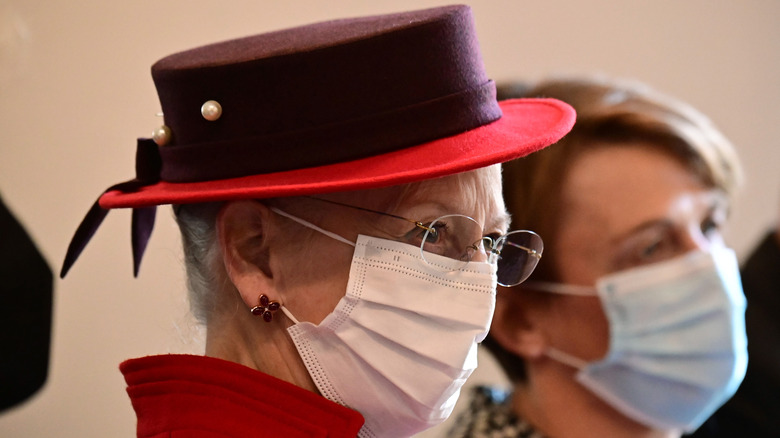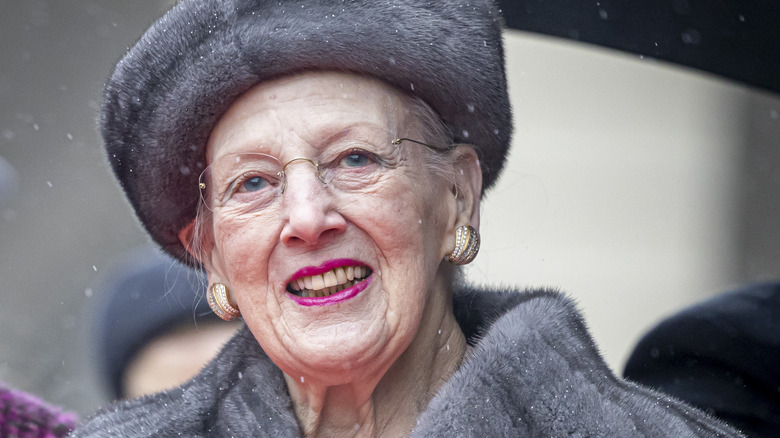All Of Queen Margrethe II Of Denmark's Health Issues Explained
After making her surprising announcement that she would abdicate the throne in January 2024, public interest has increased around 83-year-old Queen Margrethe II of Denmark. This popular queen reigned for 51 years, and she even kept up with some of the personal pursuits she had before ascending the throne, including art and design (per ABC News in Australia).
According to the Danish Royal House, she became the first monarch in over 900 years to abdicate the throne (set to take place January 14). She was also considered the longest-reigning monarch in Europe. Despite her long and (overall) popular reign, however, part of the reason Margrethe decided to abdicate the throne in 2024 was due to increasing health concerns. While it's certainly normal for someone in their 80s like Margrethe to experience health difficulties, some of Margrethe's health issues are a culmination of decades of problems. She's also had other health scares over the years, most of which she recovered from relatively quickly.
Queen Margrethe II smoked for most of her life until 2023
While smoking was certainly more common in Queen Margrethe's generation, it wasn't often that you saw a member of a royal family lighting up cigarettes. This even earned her the nickname of the "smoking Queen," according to The Sydney Morning Herald, due to her public chain-smoking habits. While unimaginable in today's world, the Daily Mail reported previous instances where Queen Margrethe smoked on public transit and at official appearances, and she even helped her mother, Queen Ingrid, light up her cigarettes as a teenager. Due to increasing scrutiny from health experts, as well as new Danish laws, Queen Margrethe started to smoke a bit less in public in 2006. It wasn't until 2023, however, when the queen reportedly quit smoking altogether after 66 years of use. This was due to other concerns about her health, which may have been exacerbated by her smoking habit.
It's never too late to stop smoking for your health's sake, and Queen Margrethe proved that this can be done, even in your early 80s. What's worth noting, however, is the fact that Margrethe even reached this stage in her life, as the American Heart Association states that smokers, especially those who start young as in the queen's case, may experience shortened lifespans and a higher risk of cardiovascular disease. The Queen has indeed had her share of health issues, though heart disease is not known to be one of them.
In 1994, Queen Margrethe underwent cervical cancer treatment
One of Queen Margrethe II's earliest known health issue was cervical cancer. According to the Mirror, she was successfully treated for the disease in 1994. This type of cancer begins within cervical cells, and it may spread beyond the cervix to other parts of the female reproductive system. It's also considered a slow-growing cancer, with the National Cancer Institute estimating a 91% five-year survival rate when diagnosed in early stages.
Not much is known about the circumstances, including the stage of Queen Margrethe's cancer, but we do know that it was detected and treated early. Also, the American Cancer Society notes that women who smoke are twice as likely to develop cervical cancer compared with non-smokers. It's thought that during the process of smoking, toxins from cigarettes are released in your bloodstream, and they may damage the DNA of body cells, such as those in the cervix. However, there's no way of knowing for sure whether smoking contributed to Margrethe's cancer. It's also important to know that other risk factors for this cancer may be out of your control, such as certain infections and family history of cancer.
In December 2001, Queen Margrethe experienced a frightening fall
The holidays are at time for relaxation, but Christmas vacation in 2001 undoubtedly ended up being an anxious one for Queen Margrethe II and her family. According to a report from News 24, the queen fell on December 26 that year, and she ended up breaking two of her ribs. The incident happened at the Marselisborg Castle during a vacation in Aarhus, Denmark. She was 61 years old at the time of the frightening fall, per the Orlando Sentinel.
After the accident, Queen Margrethe was rushed to a hospital, where X-rays confirmed the broken ribs on the left side of her ribcage. Thankfully, however, the queen suffered no further injuries, and she was still able to fulfill some of her usual royal commitments for the holiday season, including an annual New Year's Eve speech to Denmark.
In 2003, Queen Margrethe underwent back surgery for spinal stenosis
Just a little over a year after her fall at the Marselisborg Castle in 2001, Queen Margrethe II had a surgery for an unrelated back problem. In mid-January 2003, the Queen underwent back surgery for ongoing issues associated with spinal stenosis. According to a 2003 report from Midland Daily News, Queen Margrethe had the procedure at Aarhus City Hospital, where her spinal column was repaired. In all, the operation took four hours to complete. (Her surgery also required a team of four surgeons!) After the Queen's surgery, she was required to stay in the hospital for a week while she recovered.
Before she underwent this treatment for spinal stenosis, Queen Margrethe was also publicly dealing with the excruciating back pain that's common with this disorder. As Midland Daily News reported at the time, the Queen had to sit during some of her annual New Year's celebrations about a week before her surgery. The effects of the surgery seemed to help for several years, however. As the Mayo Clinic notes, surgery can be an effective method for creating space in the spine and reducing related pain from pressure on the backbone, but it doesn't cure spinal stenosis. The non-profit medical group also points out that spinal stenosis mostly affects adults over 50 years old, with osteoarthritis being a common cause.
Queen Margrethe had surgery for a hernia in 2006
A few years after her back surgery for spinal stenosis, Queen Margrethe II had an operation for a completely unrelated issue. This time, as United Press International reported in September 2006, Margrethe had surgery for a hernia. While the treatment was successful, the Queen needed to rest for a few days, with her husband, the late Prince Henrik, taking over some of Margrethe's scheduled commitments. This included an appearance at the European Cultural Awards, which took place at the royal palace.
While there weren't many details available about Queen Margrethe's hernia and surgery, this health condition is relatively common, according to Johns Hopkins Medicine. Women like Margrethe are more likely to develop abdominal hernias, which can cause a protrusion of inner organs through the muscle wall. Needless to say, this is a very painful condition that requires surgical repair. As the Cleveland Clinic reports, surgery is a first-line treatment option for hernia, and it usually has a long-term success rate. Such seems to be the case with Margrethe, who hasn't appeared to suffer a recurrence.
In 2007, Queen Margrethe underwent a knee replacement
Spinal stenosis and the subsequent pain aren't the only joint related issues Queen Margrethe II experienced. In fact, the Queen has also dealt with osteoarthritis in her knees, with her right knee reportedly being the most affected. As Midland Daily News reported, Margrethe previously had smaller operations to remove cartilage dating back to 1992 and 1993, and later in 2001. These issues seemed to come up again in the mid-2000s, resulting in a total knee replacement for the Queen. In February 2007, 66-year-old Margrethe visited Aarhus City Hospital once again, where she underwent surgery for her right knee, according to The Sydney Morning Herald. Unlike her smaller operations in the 1990s though, this time her right knee received a total artificial replacement. The surgery itself took about an hour, and Margrethe subsequently entered a rehabilitation program. "It is expected that the queen will gradually carry out a few visits and other duties in the coming months," royal household spokesperson Ove Ullerup said in a statement at the time.
While her knee osteoarthritis and resulting replacement undoubtedly caused pain and a disrupted schedule for Margrethe, such issues aren't uncommon. In fact, according to the American Academy of Orthopaedic Surgeons, osteoarthritis is not only the most common form of arthritis, but it is also most prevalent in the knee. It mostly develops in adults over the age of 50. They also note that surgery is usually a last resort, as was likely the case for Margrethe.
In 2022, Queen Margrethe was diagnosed with COVID-19 twice
By 2022, it seems that almost everyone had come down with a COVID-19 infection at some point. At this point in the pandemic, some people even reported getting COVID-19 multiple times. Queen Margrethe II was no exception, though in her case, she was diagnosed more than once in the same year. Her first case of COVID-19 was in February 2022, when she was 81 years old, according to Reuters. At the time, the royal house released a statement that Margrethe was experiencing mild symptoms. Nevertheless, per protocol, the Queen isolated at her home at the Amalienborg Palace, and she also canceled a vacation she was set to have in Norway. Margrethe recovered without any further issues.
About seven months later, however, Margrethe came down with yet another COVID-19 infection. This time, the now 82-year-old tested positive in September 2022, according to The Guardian. It's thought that Margrethe contracted the virus after traveling to Queen Elizabeth II's funeral earlier that month. Still, Margrethe, who was also vaccinated, recovered from the virus as she self-isolated and canceled her royal commitments.
In early 2023, Queen Margrethe had a second back surgery
Queen Margrethe II first underwent back surgery for spinal stenosis in 2003. About two decades later, the Queen had a second back surgery for ongoing pain related to spinal stenosis. "For quite some time, Her Majesty has been affected by problems with her back, and the situation has worsened recently," said an official statement from the Royal House on February 8, 2023. "After consultation with Rigshospitalet's specialists, The Queen has decided to undergo extensive surgery." The operation itself took place on February 22, and Queen Margrethe wasn't released from the hospital until March 2, according to the Associated Press.
The recovery process also seemed lengthier than her first back surgery, as Margrethe was unable to fulfill some of her royal duties while she recovered. Some of her royal engagements that couldn't be canceled were instead attended by her son, Crown Prince Frederik, or other members of her family. This even included an international trip to India, where the Crown Prince was also accompanied by his wife, Crown Princess Mary, according to People.
She experienced a lengthy recovery process after her second back surgery
Despite having a successful surgery for her back that was free of complications, the recovery process was undoubtedly longer for Queen Margrethe II compared to the treatment she had 20 years earlier. Not only was the recovery process challenging from a physical standpoint, but Margarethe was also unable to attend key events, such as the coronation of King Charles III in May 2023, according to Royal Central. Additionally, she postponed a summer vacation until the following year. Margarethe did make her first public appearance two months after her surgery, just before her 83rd birthday, but People also reported that she needed assistive aids, such as a walking stick and a chair to help ease her mobility struggles, further highlighting the fact that the Queen was very much still in the middle of recovery.
Due to her age and ongoing back problems, Margarethe made her surprise announcement that she would abdicate the throne on January 14, 2024. In referring to her 2023 back surgery, the Queen said during the announcement, per BBC, "The surgery naturally gave rise to thinking about the future — whether the time had come to leave the responsibility to the next generation."
